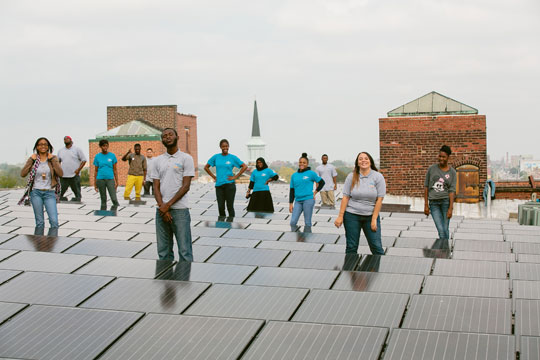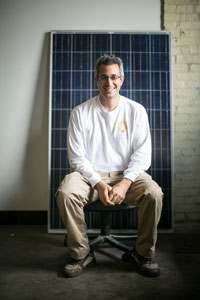 Story by Ruth Heil, photos by Neal Santos.
Story by Ruth Heil, photos by Neal Santos.
As the founder of Solar States, a South Kensington-based solar energy consulting and installation company, Micah Gold-Markel knows something about tapping underutilized potential. When he looked at Philadelphia’s public schools, he saw plenty of it, both on the unadorned rooftops, and in the classrooms underneath them.
 Micah Gold-Markel, Founder of Solar States“I became captivated by solar energy,” says Gold-Markel. “It’s just so cool that you can make energy directly from the sun.” Gold-Markel saw something missing from the equation, however. “Urban kids were really missing out on the sustainability boat.” But he had an idea that could change that: the Philadelphia Solar Schools Initiative (PSSI), a link between Philadelphia’s green future and the cultivation of its young adults. “We all need to be involved in order for this to work,” he says.
Micah Gold-Markel, Founder of Solar States“I became captivated by solar energy,” says Gold-Markel. “It’s just so cool that you can make energy directly from the sun.” Gold-Markel saw something missing from the equation, however. “Urban kids were really missing out on the sustainability boat.” But he had an idea that could change that: the Philadelphia Solar Schools Initiative (PSSI), a link between Philadelphia’s green future and the cultivation of its young adults. “We all need to be involved in order for this to work,” he says.
The multi-pronged PSSI combines an innovative program to bring solar power to 20 Philadelphia schools with a sustainable energy education effort that includes in-school classes and vocational training to prepare the students for “green collar” career opportunities.
Such innovation in pursuit of green energy is nothing new for Gold-Markel. He was awarded a PennFuture “Green Power: Turn It On!” award in 2011, after Solar States installed a 81.5k kilowatt solar array above its offices in South Kensington’s Crane Arts Building. The installation was made possible through a power-purchase agreement in which Crane Arts agreed to buy the power generated.
The first part of the PSSI program was setting a goal of installing 5,000 solar panels — enough to produce 1.5 megawatts — on the roofs of 20 city schools.
Solar States will finance, install, own and operate the solar arrays, selling the energy generated directly to the schools hosting the arrays, at a price lower than what the school can get from other electric suppliers. Clean Currents has agreed to buy the Solar Renewable Energy Credits (SRECs) for which the arrays will be eligible, helping Solar States keep prices low. SRECs are a common financial device businesses can purchase to “go green” by supporting renewable energy.
Since the electricity will be generated on-site, there will be virtually no loss during transmission (compared to losses of as much as 15 percent for electricity produced off-site). “We anticipate the array will generate 30 to 50 percent of the energy consumed by most schools,” says Gold-Markel. “The rest of the energy will hopefully come from Clean Currents, which sells 100 percent renewable energy.”
While Gold-Markel is excited about putting solar arrays atop the schools, he is even more excited by the initiative’s focus on preparing Philadelphia’s youth for work in the growing green jobs sector. He has partnered with the YouthBuild Philadelphia Charter School on North Broad Street, where he now teaches a class to 15 students who have recently returned to school after having dropped out. Martin Molloy, YouthBuild’s director of vocational training, says, “These are 18- to 21-year-olds who’ve figured out — usually through harsh reality — that education is paramount to their lives.”
Each day, the class exposes students to the possibilities of change. Gold-Markel’s teaching style is down-to-earth, capturing the kids’ interest by asking what they think, feel and already know, then framing lessons in ways that are relevant to their world. “[Solar Schools] is probably one of my favorite classes,” wrote student Tiaira Wright. “It’s informative, interesting and fun. I can’t wait to see what Mr. Micah has in store for us throughout the course of the school year.”
Although the school year is only a few weeks old, according to Molloy, “So far, the students are more engaged and have reported more interest in the Solar Schools piece of the day than anything else we’ve done.”
After the current one-year session, students will advance to college-level classes that suit their individual aptitudes and interests, with the continued support of the YouthBuild program. Gold-Markel is hopeful that some will go on to become solar engineers. Next year, he plans to offer students hands-on solar vocational training. Some students may also move on from the secondary education program straight to employment, perhaps by Solar States. “We’re looking at some of those students,” Gold-Markel says. “And they look like good candidates for us.”
But solar development requires more than engineering and labor. It takes financial planning, strategic thinking, negotiation and marketing. “There is room for workers of all sorts of skills in solar,” he adds.
 Students from Youthbuild Philadelphia Charter School studying solar technologyThe current curriculum is part of a bigger plan. Gold-Markel intends to have this year’s students create a viable business plan that will help Solar States raise the cash needed to install the arrays on the schools. And it will give the kids, “real-world experience pitching banks and other folks with their business plan to try and get funding. That’s how business works in America. Unless you have a plan that people can believe in, nobody’s going to fund you. A good idea isn’t enough.”
Students from Youthbuild Philadelphia Charter School studying solar technologyThe current curriculum is part of a bigger plan. Gold-Markel intends to have this year’s students create a viable business plan that will help Solar States raise the cash needed to install the arrays on the schools. And it will give the kids, “real-world experience pitching banks and other folks with their business plan to try and get funding. That’s how business works in America. Unless you have a plan that people can believe in, nobody’s going to fund you. A good idea isn’t enough.”
PSSI is “a win-win-win for everyone,” says Gold-Markel. The kids win when they learn to facilitate change and participate in meaningful employment that is in high demand. The schools win when they generate their own power. The city wins as it gets closer to achieving its sustainability goals.
Still, great challenges exist. PSSI is unfunded beyond Solar States’ one-year commitment, and Gold-Markel is planning a campaign to raise the estimated $40,000 operating budget required to teach the daily class for one school year. Also, more schools must join the initiative. Several schools have signed on, and others are in the pipeline, but more are needed.
Despite the challenges, Gold-Markel is excited about the prospect of creating green collar jobs for his students, whether they install solar panels on school roofs, commercial roofs or the tops of Philadelphia residences. He is enthusiastic about their potential to become part of a climate-change solution, and hopeful they will help the city become a leader in solar power.
“Solar States, under the leadership of Micah Gold-Markel, has been one of the standout business advocates for Pennsylvania’s solar industry,” says Evan R. Endres, project manager for PennFuture Solar Programs. “Rare is the business that directs capital and talent toward projects that benefit the public good and the bottom line; Solar States is a standout example.”
Standing in the crisp fall air on top of the Crane Arts Building, Gold-Markel overlooks the array his company installed. “So, this is what 444 solar panels looks like,” he says. In between his vantage point and the majestic Center City skyline stands a vastocean of rooftop possibilities, each one patiently waiting for someone to come along and capitalize on its future potential. But Gold-Markel knows that more important than the potential of what goes on top of those roofs is the potential of the kids who live under them.
“When you think about the future,” he says, “it all comes down to the kids.”






